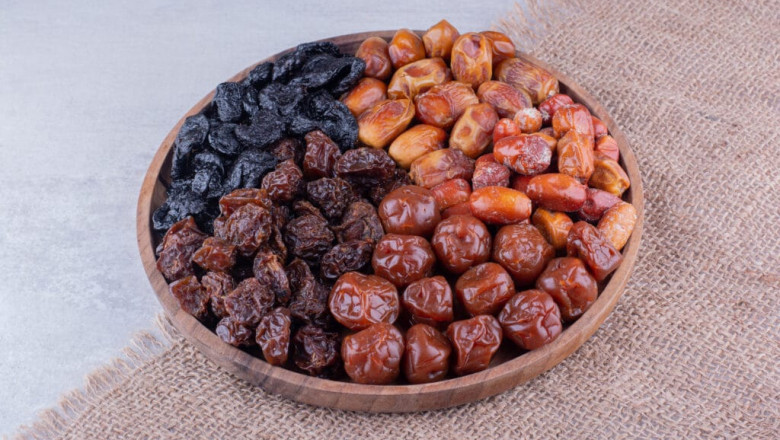views
How Dates Are Made: From Farm to Table
Dates are one of nature’s sweetest and most versatile fruits, enjoyed for their taste and health benefits. But have you ever wondered how dates make their journey from the farm to your table? The process of cultivating and harvesting dates is a fascinating blend of tradition, technology, and care.
In this blog, we’ll explore the step-by-step process of how dates are made, their nutritional benefits, and why they’re considered a superfood.
Step 1: Cultivation of Date Palms
Dates grow on date palms (Phoenix dactylifera), which thrive in hot, arid climates. The Middle East, North Africa, and parts of India are known for their ideal conditions for date cultivation.
Key Aspects of Date Palm Cultivation:
- Climate: Requires high temperatures and minimal rainfall.
- Soil: Sandy or loamy soil with good drainage is ideal.
- Watering: Drip irrigation systems are commonly used to conserve water while ensuring consistent hydration.
Farmers carefully select high-quality date palm saplings or seeds to ensure a productive harvest.
Step 2: Pollination
Date palms rely on pollination to produce fruit. This process can occur naturally through wind or insects, but most commercial date farms use manual pollination to ensure better yields.
How Manual Pollination Works:
- Male flowers are collected and their pollen is dusted onto female flowers.
- This ensures proper fertilization, leading to healthy date clusters.
Step 3: Growth and Development
Once pollinated, dates begin to grow in clusters. Over the next six to seven months, the fruit undergoes four stages of development:
- Kimri (Unripe): Hard and green.
- Khalal (Color Changing): Turns yellow or red, depending on the variety.
- Rutab (Ripening): Becomes soft and develops sweetness.
- Tamar (Fully Ripened): Dark, sweet, and ready for harvest.
Farmers monitor the fruit closely during this time, protecting it from pests and harsh weather.
Step 4: Harvesting
Harvesting dates is a labor-intensive process that requires precision and care.
- When to Harvest: Dates are harvested when they reach the desired stage of ripeness, depending on the variety.
- How It’s Done: Workers climb the tall palms or use mechanical lifts to reach the date clusters. The fruit is carefully cut to avoid bruising.
Step 5: Sorting and Cleaning
After harvesting, dates are sorted and cleaned to remove impurities.
- Sorting: Dates are categorized based on size, color, and ripeness.
- Cleaning: They are washed to remove dust and dirt while ensuring hygiene.
This step is crucial for maintaining the quality and safety of the fruit.
Step 6: Drying and Processing
Some varieties of dates are dried to enhance their sweetness and shelf life.
- Drying: Dates are sun-dried or dried using specialized equipment to reduce moisture content.
- Processing: Includes pitting, chopping, or coating with natural preservatives to prepare them for packaging.
Step 7: Packaging and Storage
Once processed, dates are packed in airtight containers or vacuum-sealed packs to preserve freshness.
- Packaging: Designed to protect the fruit from moisture and contamination.
- Storage: Stored in cool, dry environments to maintain quality until they reach consumers.
Health Benefits of Dates
Dates are often referred to as a superfood because of their rich nutritional profile.
- Energy Boost: High in natural sugars like glucose and fructose, dates are an instant source of energy.
- Rich in Fiber: Promotes digestion and prevents constipation.
- Packed with Nutrients: Contains essential vitamins and minerals like potassium, magnesium, and vitamin B6.
- Antioxidant Properties: Fights free radicals and supports overall health.
- Natural Sweetener: A healthier alternative to refined sugar in recipes.
Popular Varieties of Dates
- Medjool Dates: Known for their large size, soft texture, and caramel-like flavor.
- Deglet Noor Dates: Semi-dry dates with a mild, nutty taste.
- Ajwa Dates: A small, soft variety with a rich flavor, often considered sacred in Islamic traditions.
- Barhi Dates: Sweet and creamy, often eaten fresh.
- Sukkari Dates: Known for their extreme sweetness and golden color.
Tips for Enjoying Dates
- Snacking: Eat them as a quick, healthy snack.
- Baking: Use them as a natural sweetener in cakes, cookies, and energy bars.
- Smoothies: Blend dates with milk or yogurt for a creamy, nutritious drink.
- Stuffing: Fill dates with nuts or cream cheese for an elegant appetizer.
Fun Facts About Dates
- Dates are one of the oldest cultivated fruits, dating back over 5,000 years.
- A single date palm can produce up to 200 pounds of fruit annually.
- Dates are often called "the bread of the desert" because of their nutritional value and long shelf life.
Conclusion
From the meticulous cultivation of date palms to the careful processing and packaging, the journey of how dates are made is truly remarkable. These sweet, nutrient-rich fruits are a testament to the skill and dedication of farmers and producers.
Whether enjoyed as a snack, a sweetener, or a gourmet treat, dates are a versatile addition to any diet. Incorporate them into your meals and experience the natural goodness they bring to your table.






















Comments
0 comment